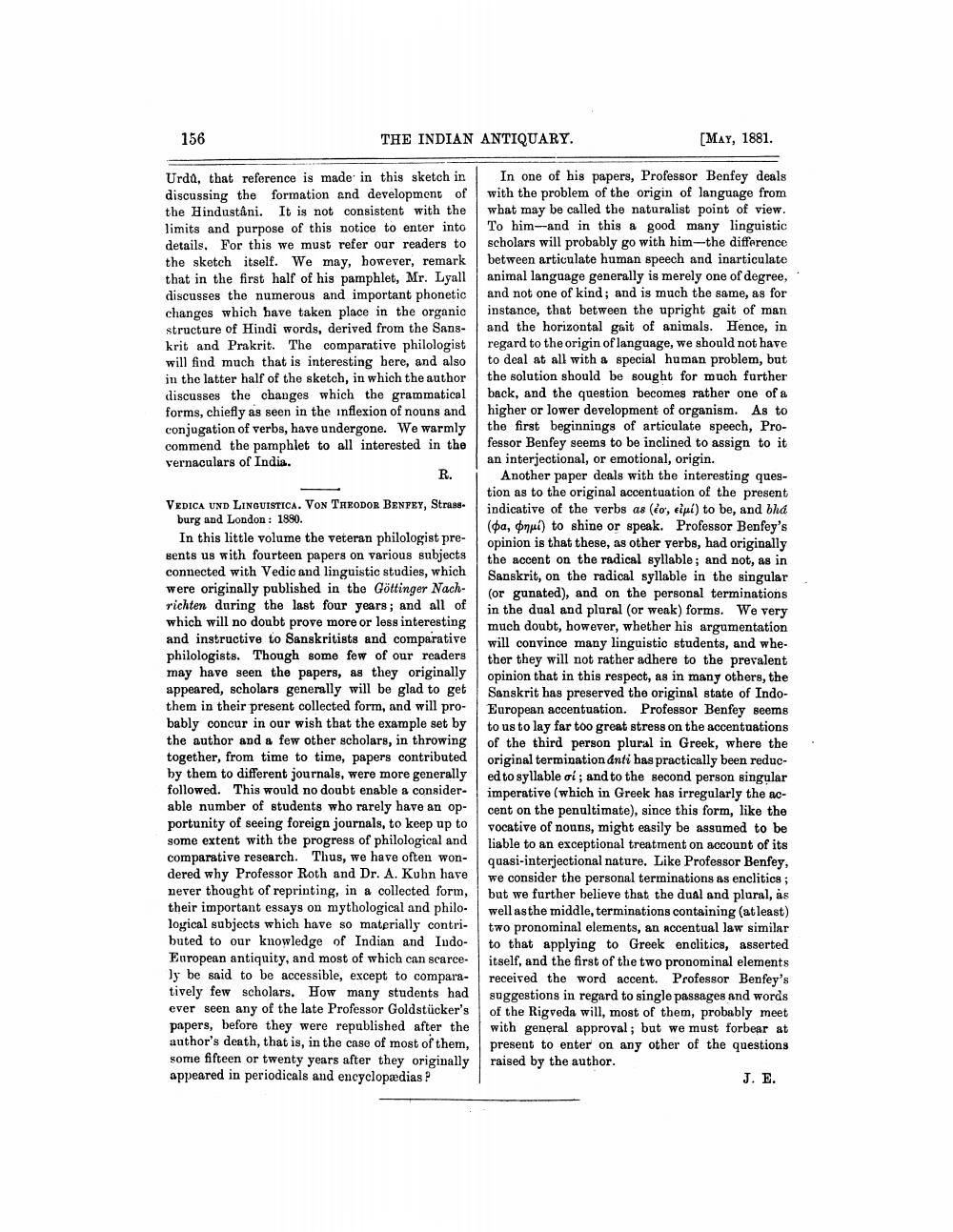________________
156
THE INDIAN ANTIQUARY.
[MAY, 1881.
Urda, that reference is made in this sketch in discussing the formation and development of the Hindustani. It is not consistent with the limits and purpose of this notice to enter into details. For this we must refer our readers to the sketch itself. We may, however, remark that in the first half of his pamphlet, Mr. Lyall discusses the numerous and important phonetic changes which have taken place in the organic structure of Hindi words, derived from the Sanskrit and Prakrit. The comparative philologist will find much that is interesting here, and also in the latter half of the sketch, in which the author discusses the changes which the grammatical forms, chiefly as seen in the inflexion of nouns and conjugation of verbs, have undergone. We warmly commend the pamphlet to all interested in the vernaculars of India.
R.
VEDICA UND LINGUISTICA. Von THEODOR BENFEY, Strassburg and London : 1880.
In this little volume the veteran philologist preBents us with fourteen papers on various subjects connected with Vedic and linguistic studies, which were originally published in the Göttinger Nachrichten during the last four years, and all of which will no doubt prove more or less interesting and instructive to Sanskritists and comparative philologists. Though some few of our readers may have seen the papers, as they originally appeared, scholars generally will be glad to get them in their present collected form, and will pro- bably concur in our wish that the example set by the author and a few other scholars, in throwing together, from time to time, papers contributed by them to different journals, were more generally followed. This would no doubt enable a consider. able number of students who rarely have an op- portunity of seeing foreign journals, to keep up to some extent with the progress of philological and comparative research. Thus, we have often wondered why Professor Roth and Dr. A. Kuhn have never thought of reprinting, in a collected form, their important essays on mythological and philological subjects which have so materially contributed to our knowledge of Indian and IndoEuropean antiquity, and most of which can scarcely be said to be accessible, except to comparatively few scholars. How many students had ever seen any of the late Professor Goldstücker's papers, before they were republished after the author's death, that is, in the case of most of them, some fifteen or twenty years after they originally appeared in periodicals and encyclopædias ?
In one of his papers, Professor Benfey deals with the problem of the origin of language from what may be called the naturalist point of view. To him--and in this a good many linguistic scholars will probably go with him-the difference between articulate human speech and inarticulate animal language generally is merely one of degree, and not one of kind; and is much the same, as for instance, that between the upright gait of man and the horizontal gait of animals. Hence, in regard to the origin of language, we should not have to deal at all with a special human problem, but the solution should be sought for much further back, and the question becomes rather one of a higher or lower development of organism. As to the first beginnings of articulate speech, Professor Benfey seems to be inclined to assign to it an interjectional, or emotional, origin.
Another paper deals with the interesting question as to the original accentuation of the present indicative of the verbs as (io, cipi) to be, and bhd (pa, onui) to shine or speak. Professor Benfey's opinion is that these, as other yerbs, had originally the accent on the radical syllable; and not, as in Sanskrit, on the radical syllable in the singular (or gunated), and on the personal terminations in the dual and plural (or weak) forms. We very much doubt, however, whether his argumentation will convince many linguistic students, and whether they will not rather adhere to the prevalent opinion that in this respect, as in many others, the Sanskrit has preserved the original state of IndoEuropean accentuation. Professor Benfey seems to us to lay far too great stress on the accentuations of the third person plural in Greek, where the original termination anti has practically been reduced to syllable oi; and to the second person singular imperative (which in Greek has irregularly the accent on the penultimate), since this form. like the vocative of nouns, might easily be assumed to be liable to an exceptional treatment on account of its quasi-interjectional nature. Like Professor Benfey, we consider the personal terminations as enclitics; but we further believe that the dunl and plural, as well as the middle, terminations containing (at least) two pronominal elements, an accentual law similar to that applying to Greek enclitics, asserted itself, and the first of the two pronominal elements received the word accent. Professor Benfey's suggestions in regard to single passages and words of the Rigveda will, most of them, probably meet with general approval; but we must forbear at present to enter on any other of the questions raised by the author.
J. E.




